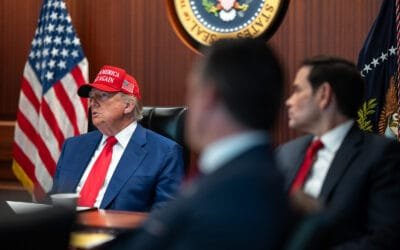In the past year, foreign nations taking IMF advice on currency, tax and banking policies have suffered over $200 billion in loan losses and capital flight. The IMF has been pouring the funds of Western taxpayers into these regimes as fast as local wealth has been destroyed. The Republican Congress, which was critical of the IMF last summer, just conceded to demands by the Clinton Adminstration to inject $90 billion more into the IMF, of which $18 billion will come from U.S. taxpayers. In effect rewarded for malpractice, the quack IMF is poised to inject $30 billion into Brazil, in return for its full adoption of IMF policies. If Brazil accepts, it will, like the others, wreck its currency and economy. More IMF funding requests will come.
Instead of re-funding the IMF or reforming it, Congress should abolish it outright. The IMF is a destructive, crisis-generating global welfare agency. It promoted bad policy in Mexico in 1994 which led to a bailout in 1995. It promoted similar policies in Southeast Asia in 1997, leading to still more bailouts. Then Russia. Now Brazil. The world crisis is no failure of markets but of government intervention in markets. The IMF cannot cure what is called the “Asian contagion”–since it is generating the very germs that are causing the disease. The contagion reflects the spread of germs better known as bad ideas–that currency devaluations (hyperinflations), higher taxes, higher interest rates and capital controls–standard instruments in the IMF’s “austerity” quack kit–bring prosperity.
Not long ago economists described the “Asian miracle.” For over a decade, production and jobs grew faster in that region than anywhere else in the world. Living standards skyrocketed. But this was no inexplicable “miracle.” Asia prospered to the extent that governments refrained from economic intervention. During its period of impressive growth, currencies held their value, inflation and taxes were low, government budgets were balanced, and cross-border flows of labor and capital were relatively unregulated.
What changed? Starting in 1997, the governments of such countries as Thailand, Malaysia, South Korea and Singapore–in keeping with the IMF’s policies–decided to devalue, that is, to massively lower the value of their currencies relative to other world monies. Until then, local currencies had been fixed to the U.S. dollar and had thus shared in the dollar’s relatively stable value over the past decade. Russia’s ruble had also been tied to the dollar, until the IMF pushed for devaluation and debt defaults last August. The IMF claims devaluations can promote exports and economic growth.
The actual result was that borrowers who had contracted debts in dollars, expecting them to be interchangeable with local money, had to default. Widespread bankruptcies ensued. As currency values grew indeterminate–because of the unpredictability of government intervention–international trade stagnated. Foreign capital fled. Banks failed. Unemployment soared. And long-exiled “strong men” entered political offices, pledging to restore “discipline.”
Much of the blame for this chaos rests with the IMF itself. Officials of the agency have been trained to believe in mercantilism, the statist notion that one country’s wealth is achieved at the expense of another’s. On this view, each government discourages imports and encourages exports. Trade deficits, immigrants and foreign capital are distrusted. Trade and capital “imbalances” or undue “foreign influences” must be rectified by protectionist measures.
The IMF encourages currency devaluations, which curtail imports by making them more expensive. (This is why Indonesia’s attempt last spring to re-stabilize its currency by tying it to the dollar again was opposed by the IMF.) As one country after another adopts this policy, trade shrinks and the contagion spreads still further. All this uncertainty associated with arbitrarily manipulated currency values causes capital to leave and productive activity to stall–as evidenced by upheaval in Asia, Russia, and now Brazil.
But what is the IMF’s recommended “cure” for the disease brought on by its own interventionist prescriptions? More statist intervention. In return for bailouts, countries must enact such measures as new taxes, high interest rates, nationalizations, deportations, and price controls. Far from being an economic “doctor,” the IMF is in fact a quack, which first advises an otherwise healthy producer to slit his wrists (i.e., to devalue and cause capital to flow out), and then, as the patient loses strength, counsels blood-letting (i.e., tax hikes and interest-rate increases).
It is true that many of Asia’s and Russia’s problems come from “crony capitalism”–but it is the “crony” element, not the “capitalism” element, that needs to be excised. “Cronyism” is a feature precisely of the statist economics endorsed by Harvard, MIT and its cronies at the IMF. Its involvement intensifies cronyism, since it magnifies the state’s role in business. Capitalism, by contrast, is based not on the dispensation of government favors to business, but on the complete separation of state and business.
The IMF claims its involvement with Mexico was a success story. Not so. Mexico fell into crisis when, at the IMF’s instigation, it devalued the peso in 1994-95. Only when Mexico re-established a peso that was semi-fixed to the dollar and weaned itself from IMF aid did its economy recover. Asia, Russia and Brazil too, can recover–but only when they reign in government by instituting property rights, establishing a non-manipulable currency, allowing free trade, and kicking out the IMF. That’s not easy, when Alan Greenspan and Robert Rubin shill for IMF funding in Congress, falsely implying that refusal to fund makes Congress culpable for the crises.
What happened to the lessons we supposedly learned from the worldwide collapse of socialism? If we see the evils of a government-managed economy, why can’t we see the same evils of a government-run global management agency that offers additional subsidies and controls? It’s time that capitalism–true, laissez-faire capitalism–be allowed to function. That is, no subsidies, bailouts, or controls, not for the smallest wage-earners or the biggest banks.
The IMF, having dissipated its reserves in a $200 billion effort to prop up failing borrowers in Southeast Asia, Russia and Brazil, has now received another transfusion. It has squeezed out still more blood from us so that it can continue practicing its life-draining statism. There will be further bleeding to come, and more refunding requests. It’s time to say no to all this blood-letting.









